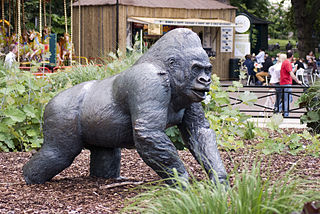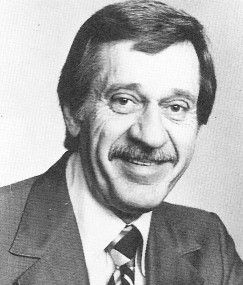Related Research Articles

Gorillas are herbivorous, predominantly ground-dwelling great apes that inhabit the tropical forests of equatorial Africa. The genus Gorilla is divided into two species: the eastern gorilla and the western gorilla, and either four or five subspecies. The DNA of gorillas is highly similar to that of humans, from 95 to 99% depending on what is included, and they are the next closest living relatives to humans after chimpanzees and bonobos.

Hanabiko "Koko" was a female western lowland gorilla. Koko was born in San Francisco Zoo, and lived most of her life at The Gorilla Foundation's preserve in the Santa Cruz Mountains. The name "Hanabiko" (花火子), lit. 'fireworks child', is of Japanese origin and is a reference to her date of birth, the Fourth of July. Koko gained public attention upon a report of her having adopted a kitten as a pet and naming him "All Ball", which the public perceived as her ability to rhyme.
Binti Jua is a female western lowland gorilla in the Brookfield Zoo, in Brookfield, Illinois, United States, outside of Chicago. She received media attention after a situation in 1996 in which she tended to a three-year-old boy who had been injured by falling into her enclosure.

The mountain gorilla is one of the two subspecies of the eastern gorilla. It is listed as endangered by the IUCN as of 2018.
Francine "Penny" Patterson is an American animal psychologist. From 1972 onwards, she taught a modified form of American Sign Language, which she called "Gorilla Sign Language" (GSL) to a gorilla named Koko. The scientific validity of Patterson's claims about the extent of Koko's language mastery has been debated.

The western lowland gorilla is one of two Critically Endangered subspecies of the western gorilla that lives in montane, primary and secondary forest and lowland swampland in central Africa in Angola, Cameroon, Central African Republic, Republic of the Congo, Democratic Republic of the Congo, Equatorial Guinea and Gabon. It is the nominate subspecies of the western gorilla, and the smallest of the four gorilla subspecies.
The Gorilla Foundation is a non-profit organization founded in 1976 by Francine Patterson and Ronald Cohn with Barbara F. Hiller.

Jambo was a gorilla housed at Durrell Wildlife Park in Jersey, Channel Islands. He was involved in an incident in which he was seen to be protective of a child who fell into his enclosure.
Michael was the first male 'talking' gorilla. He had a working vocabulary of over 600 signs in American Sign Language, taught to him by Koko, a female gorilla; Francine Patterson ; and other staff of Stanford University. Michael, an orphan, spent most of his life in Woodside, California, where he became a local celebrity and painter, creating vividly colourful abstract works.

The eastern gorilla is a critically endangered species of the genus Gorilla and the largest living primate. At present, the species is subdivided into two subspecies. There are 6,800 eastern lowland gorillas or Grauer's gorillas and 1,000 mountain gorillas. Illegal hunting threatens the species.
Pogo was a female western lowland gorilla who was a feature of the Gorilla World exhibit at the San Francisco Zoo. Pogo was a childless but motherly matriarch, loved by generations of San Franciscans. When she died at the age of 48, she was believed to have been one of the oldest living gorillas in captivity.

Guy the Gorilla (1946–1978) was a western lowland gorilla who was London Zoo's most famous resident and often profiled on children's TV shows and natural history productions. The exact day of Guy's birth was unknown, but the official birthday was set by the Zoo as May 30, and he received large numbers of cards each year.

Harambe was a western lowland gorilla who lived at the Cincinnati Zoo. On May 28, 2016, a three-year-old boy visiting the zoo climbed under a fence into an outdoor gorilla enclosure where he was violently grabbed and dragged by Harambe. Fearing for the boy's life, a zoo worker shot and killed Harambe. The incident was recorded on video and received broad international coverage and commentary, including controversy over the choice to use lethal force. A number of primatologists and conservationists wrote later that the zoo had no other choice under the circumstances, and that it highlighted the danger of zoo animals near humans and the need for better standards of care.

Glenn Ryle Schnitker (1927-1993) was a long-time television personality in Cincinnati, Ohio. He is best remembered by Cincinnatians for hosting the Skipper Ryle Show for seventeen years on WKRC Television.

Oktoberfest Zinzinnati is an annual German-heritage festival in the city of Cincinnati, Ohio. Based on the original Munich Oktoberfest, it is billed as the largest Oktoberfest celebration in the United States and second largest in the world. First held in 1976, as of 2023 it hosted over 700,000 attendees each year. It is held along six blocks of Downtown Cincinnati.

Shabani is a male western lowland gorilla, born at the Apenheul Primate Park in the Netherlands, raised in Australia and currently residing at the Higashiyama Zoo in Nagoya, Japan. He gained publicity in 2007 at Higashiyama Zoo when he was 10 years old by tightrope walking.
Timmy was a western lowland gorilla and a 25-year-long resident of the Cleveland Metroparks Zoo. He was primarily housed indoors at the Zoo's Primate, Cat & Aquatics building. The even-tempered silverback gorilla was euthanized at the Louisville Zoo after suffering from chronic cardiovascular disease and osteoarthritis in 2011.
Mefou Park, also known as Mefou Wildlife Sanctuary and Mfou Reserve, is a primate sanctuary in the forested area of Mfou in Cameroon. Within it, Mefou Primate Park is used as a shelter for primates that are native to Africa: the monkey, chimpanzees and gorillas.

Samson (1949–1981) was a male silverback western lowland gorilla given to the Washington Park Zoo in Milwaukee Wisconsin by the Pabst Brewing Company. Samson reached a weight of 652 lb (296 kg) and lived alone in a glass enclosure. He often hit the windows in frustration and managed to break the glass four times. He was moved to the Milwaukee County Zoo in 1959, and quickly became the main attraction. Samson was one of the largest gorillas in captivity.
References
- ↑ "2018.10.25 [1] Complaint With Exhibits". Cincinnati: WKRC-TV. Retrieved 2018-10-27.
- ↑ "RAMSES I (G.G.G)". Gorillas Land. Retrieved 2018-10-27.
- ↑ "Koko The Sign Language Gorilla's Mate At Center Of Zoo Lawsuit". Sacramento: KCRA-TV. Retrieved 2018-10-27.
- ↑ "When Koko the Gorilla Chatted Online". Franklin Institute. 21 June 2018. Retrieved 2018-10-27.
- ↑ "Update on Ndume's Move". Gorilla Foundation. Retrieved 2019-06-14.
- ↑ "Ndume, gorilla companion to Koko, returns to Cincinnati Zoo". San Francisco Chronicle. 14 June 2019. Retrieved 2019-06-14.
- ↑ "Ndume the gorilla coming home to the Cincinnati Zoo". WCPO . Retrieved 2019-06-14.
- ↑ "Gorilla Ndume home safe at Cincinnati Zoo". Cincinnati.com . Retrieved 2019-06-14.
- ↑ "Gorilla returns home to Cincinnati Zoo". Fox19 . Retrieved 2019-06-14.
- ↑ "WATCH LIVE: Welcome home Ndume! The Cincinnati Zoo's 37-year-old gorilla is back in the Queen City for the first time since 1991!". Fox 19 . Retrieved 2019-06-14.
- ↑ "Ndume the gorilla is back in Cincinnati". WCPO . Retrieved 2019-06-15.
- ↑ "Cincinnati Zoo files lawsuit in effort to bring Ndume the gorilla back". Cincinnati: WCPO-TV. Retrieved 2018-10-27.
- ↑ "Fight over feces-flinging gorilla Ndume goes to federal court". animals24-7.org. 27 October 2018. Retrieved 2018-10-28.
- ↑ "Cincinnati Zoo in custody fight for silverback gorilla Ndume". Cincinnati: WLWT. Retrieved 2018-10-28.
- ↑ "Federal judge orders gorilla's return to the Cincinnati Zoo". Cincinnati: Cincinnati Enquirer . Retrieved 2019-02-02.
- ↑ "Cincinnati Zoo, Gorilla Foundation agree on plan to bring Ndume back home". Cincinnati: Cincinnati Enquirer . Retrieved 2019-03-07.
- ↑ "Zoo's Fight Over Gorilla Ndume's Return To Cincinnati Continues". Cincinnati: WVXU . Retrieved 2019-06-05.
- ↑ "Transportation of gorilla at center of Cincinnati Zoo court battle delayed again". Cincinnati: WKRC-TV . Retrieved 2019-06-05.
- ↑ "Silverback gorilla Ndume arrives at Cincinnati Zoo after months-long court battle". Cincinnati: WLWT . Retrieved 2019-06-14.
- ↑ "Cincinnati Zoo Welcomes Silverback Gorilla Ndume Back Home". Cincinnati: Cincinnati Zoo . Retrieved 2019-06-14.